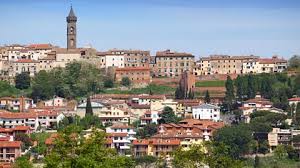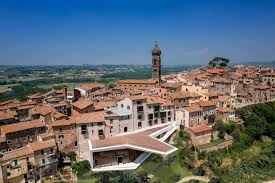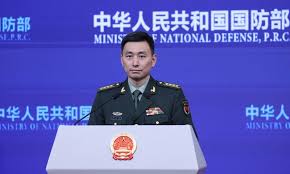Italy: Peccioli – The stunning Tuscan town even Italians don’t know

Rome: The winner of this year’s national “Borgo dei Borghi” competition blends its medieval past with an eye-catching contemporary art scene and wandering robots.
For the last 11 years, Rai, Italy’s state-owned television station, has held a contest to find Il Borgo dei Borghi, or the “Village of Villages”. The competition helps to raise the visibility of small but captivating Italian towns that might otherwise go unnoticed. The winner of this year’s competition, however, is much more than just a pretty place.
“The purpose of Il Borgo dei Borghi, is identifying these places that I think sometimes even Italians don’t know about,” Kathy McCabe, the host of the Dream of Italy TV show, tells the BBC.

The way it works is that each year, one town or village is nominated from each of Italy’s 20 regions. Local residents create videos in which they proudly show off their village’s unique history, traditions and artistic heritage. Viewers then vote for their favourite place, and the finalists are chosen by a combination of votes and a three-person “jury of experts,” made up of well-known personalities connected to Italy’s environment, history and tourism industry.
Peccioli, this year’s winner, is located just outside of the well-known city of Pisa. Perched atop a Tuscan hill and surrounded by vineyards, wheat fields and olive groves, the 5,000-person town dates back to medieval times. The village itself is a warren of old brick buildings and narrow streets and alleyways located underneath the soaring 12th-Century belltower, San Verano. But while the village is rooted in its medieval past, its modern public art has transformed Peccioli’s present.
One of the village’s most striking sites, the Palazzo Senza Tempo (“Timeless Palace”), has become a perfect example of this balance between the past and present. The building dates back to the 14th Century and boasts historical details like a beautiful medieval courtyard and stone stairways. However, in 2019, it was renovated to seamlessly incorporate more modern elements like a skylight, floor-to-ceiling windows on the ground floor that let in the light and a panoramic terrace overlooking the landscape below.
“The palace has become the cultural hub of the town,” said Peccioli resident Giulia Giaganini in the town’s Borgo dei Borghi competition video. “Representing not only the past and present but also looking toward [our] future, becoming – as its name implies – the ‘Timeless Palace’.”
Peccioli’s transformation from an unknown medieval town to one known for its blend of modern art and history came about through the use of trash, of all things. In the 1990s, in response to a change in refuse regulations, Peccioli’s leaders proposed opening up their advanced waste management systems to other towns across the region. The income generated from taking in the area’s waste was then invested back into the community, funding stunning modern art installations and sustainable technology initiatives.
“Walking through the alleyways of Peccioli is like taking a trip around the world through its art,” said another area resident, Alessandra Perna, in the competition video.
Now, the quaint medieval streets are surrounded with eye-catching art installations. Some of the most beloved examples are the Giants of Peccioli – enormous human sculptures by Polish artist Miroslaw Balka that seem to emerge from the landscape around them. Another art project by Italian artist Patrick Tuttofuoco, entitled Endless Sunset, decorates a walkway connecting the historic centre with newer areas of town on its outskirts. There’s also a new art gallery called Museum of Contemporary Art in the Open Air (MACCA) that opened in 2023 and is home to more than 600 contemporary art pieces from artists from around the world.
Amphitheatre Fonte Mazzola: Built in 2007, this 2000+ seat theatre is styled after ancient Greek theatres and is overlooked by one of the Giants of Peccioli, the enormous human sculpture titled Presenze.
Museum of Sacred Art: Located inside the church of San Verano, this cozy museum houses significant religious works dating back as far as the 12th Century such as the Madonna and Child by Enrico di Tedice and a collection of sacred jewellery.
Museum of Palazzo Pretorio: Originally a residence for various governmental authorities, this museum now houses the Bigazzi Collection, made up largely of Russian icons from the 18th to early 20th Centuries and a collection of 20th-Century engravings and lithographs.
Archaeological Museum: Believed to be an Etruscan temple or sanctuary, this museum was opened in 2004 to preserve artefacts found at the nearby site of Ortaglia and is now home to a unique collection of Etruscan objects and pieces from other eras, such as a type of ancient Greek bowl believed to have been the work of the famous Greek painter Makron.
Beyond its eye-catching art, Peccioli is also home to a variety of new technology initiatives that help with sustainability efforts.
“[Peccioli] is full of infrastructure that you cannot see anywhere else,” said Alessandro Melis, a professor in the School of Architecture and Design at New York Institute of Technology, who curated an exhibition on the town there. “For instance, in the city centre the village provides free car sharing for everybody. There are two robots, one robot is collecting the waste from the houses. And another robot is making shopping for elderly or disabled people in the city. It’s like science fiction.”
Still, this ancient town continues to look towards the future. Peccioli’s mayor is hoping to bring the town’s carbon footprint down to 0% in the next few years, and ongoing research is exploring whether it’s possible to transform waste materials into something that could safely be used for construction. In this way, this small Tuscan village will continue to hold onto its past while pushing further into the future.





